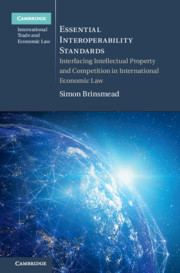 Essential Interoperability Standards
Essential Interoperability Standards Book contents
- Essential Interoperability Standards
- Cambridge International Trade and Economic Law
- Essential Interoperability Standards
- Copyright page
- Dedication
- Contents
- Foreword
- Preface
- Abbreviations
- Part I Foundations and Problems
- Part II The Impact of Intellectual Property and Competition Laws
- 4 Interoperability Standards and Intellectual Property
- 5 Interoperability Standards and Competition Law
- Part III Towards Liability and Compensation
- Bibliography
- Index
4 - Interoperability Standards and Intellectual Property
from Part II - The Impact of Intellectual Property and Competition Laws
Published online by Cambridge University Press: 26 October 2021
- Essential Interoperability Standards
- Cambridge International Trade and Economic Law
- Essential Interoperability Standards
- Copyright page
- Dedication
- Contents
- Foreword
- Preface
- Abbreviations
- Part I Foundations and Problems
- Part II The Impact of Intellectual Property and Competition Laws
- 4 Interoperability Standards and Intellectual Property
- 5 Interoperability Standards and Competition Law
- Part III Towards Liability and Compensation
- Bibliography
- Index
Summary
This chapter introduces the concept of standards-essential intellectual property (SEIP), including standards-essential patents (SEPs), standards-essential copyrights, and other applicable forms of IP. The chapter includes detailed consideration of SEPs – including a survey of scholarship of well-documented issues such as patent holdup, royalty stacking, component patenting and patent thickets – not neglecting also the availability of collective rights organizations, e.g. patent pools. Consideration is also given to applicable limiting doctrines in patent law such as defences for experimental use, as well as fundamental principles such as the requirement to publish. Detailed consideration is given to patent remedies, notably injunction and damages; compulsory licencing is also discussed. Likewise, copyright laws are considered carefully. Likewise, copyright laws are considered carefully. There is discussion of the particular situation of copyrights in relation to software and the structure of databases. There is also consideration of layout circuit and trade secret laws, as well as compulsory licensing.
Keywords
- Type
- Chapter
- Information
- Essential Interoperability StandardsInterfacing Intellectual Property and Competition in International Economic Law, pp. 81 - 156Publisher: Cambridge University PressPrint publication year: 2021
